by TRA
The History of the Pentacon Six
What might have been
The following changes were clearly needed and would have come in due course if the camera had been developed in a normal way (as in other countries of the world!).
Technical improvements
- A larger focussing screen covering the whole of the image area exposed to the film.
- The use of the “Soviet” prism, which had two advantages over the Carl Zeiss prism:
- it was much brighter
- it permitted the whole of the focussing screen to be seen – and in fact, a wide area around it, so that the whole of a larger focussing screen would have been visible without any need to modify it.
- A new shutter, using the technology that had been developed for the 35mm “L” series Prakticas in about 1971.
- This needed to be four times as fast at the original shutter, which had been developed back in the 1950s.
- This faster shutter would permit two things:
- a higher top speed, possibly 1/4000, which would have impressed the whole of the world market.
- Even if it had been decided to limit the top speed to an extremely impressive 1/2000, the other benefit would still exist:
An electronic flash sync speed of 1/100, fractionally faster than the 1/90 achieved by Hasselblad with its F series of cameras.
Other improvements would have been easy – merely transferring technology from even the “LLC” camera developed in East Germany in 1969:
- building the light meter into the camera body – there is masses of available space, compared with a 35mm camera!
- metering would then work regardless which head were used – waist-level finder, magnifier head, or prism.
- By definition, the prism would not need its own meter so it would be cheap to produce and smaller and lighter than the metering prism.
- Coupling the shutter speeds to the meter would also be simple.
- electronic transfer of lens aperture (which Pentacon itself had invented!). This would allow full-aperture metering with “EDC” Pentacon Six lenses, which Zeiss Jena and Meyer-Optik/Pentacon would have produced using the technology that they already had, while the “older” lenses could be used with stop-down metering – or Zeiss or a “third party” specialist could offer to “convert” existing lenses, which in most cases would not be difficult – it was done with the 35mm M42 lenses.
- correct connection of the delayed-action mechanism to the flash circuit, so that the flash fires when the delayed action control is used.
- There was plenty of space in the
body for batteries to be located for the metering, or
even for an electronic shutter, or a grip could
have been built onto the right of the body to
house them and simultaneously improve handling.
You can see a Pentacon Six with a hand grip here.
- An accessory flash grip could
easily have been designed. This website suggests
simple designs, the first of which I had made back in
1978. See some of these grips, starting here.
- A new “ever-ready case” with a soft front would appeal to the market, just as had the equivalent case that Pentacon introduced for their 35mm cameras.
The higher sync speed would have made less urgent a lens with a leaf or central shutter (for flash synchronisation at all speeds). However, again co-operation with Norita could have resulted in the production at negligible cost of such a lens for the Pentacon Six – again widening its appeal in world markets.
With the Arsenal plain prism, even the existing Pentacon Six case closes! And the image is brighter than with the Pentacon prism! And you can see the whole of the focussing screen! Coupled with the Rollei focussing screen, the viewfinder in such a camera (illustrated below!) is much brighter than anything that Hasselblad was offering with any body and metering prism back in the 1970s and 80s – when this camera and this prism were made! It is even brighter than anything that Hasselblad was offering in the 1990s.
Of course, such a body would not have built-in metering, but that could so easily have been incorporated. Put this beside a Pentax 6×7, Norita 66, Kiev 60 or indeed many other Medium Format SLRs, and many purchasers would have gone for this. It is smaller, lighter, quieter and more comfortable in the hand than any of the others.
Other changes needed were minor, almost cosmetic, such as improving the shape of the advance lever.
Cosmetic and stylistic improvements
In the later years of the Hasselblad 500C/M, the manufacturers stimulated sales through a series of special “limited editions”. Most of these marked anniversaries – of the market launch of the first Hasselblad, of the 500C, of the first use of Hasselblad on the moon, etc. Cameras were also offered with the body covering in a range of colours.
Pentacon had its own anniversaries that could have been celebrated – including the use of the Pentacon Six in space, “25 (40, etc) Years of Pentacon Cameras”, etc. They could also have easily responded to changes in market conditions by offering, for instance, an all-black body, or bodies with different coverings.
Once the technical side is solved (with the improvements described above), it is time to look at the experience that the camera offers and the style statement that it makes. Some people may decry this, but these are essential components in successfully marketing and selling a camera system.
Here are some examples of what they could have done.
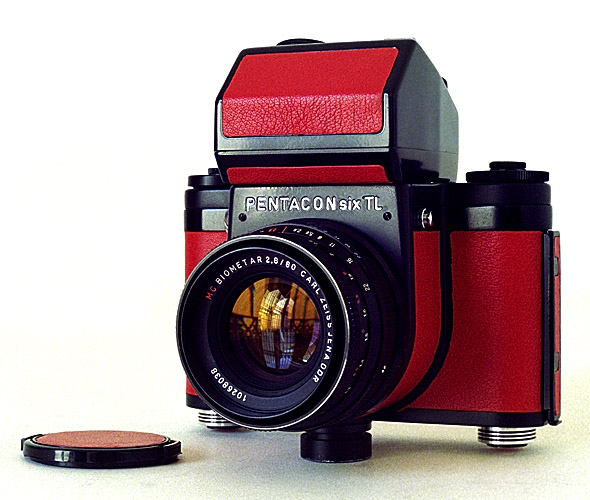
[C414_14A.jpg]
This combination exists; the other
colours suggested below are computer simulations,
unless indicated otherwise.
| The leather on the
red cameras was supplied by Gevorg Vartanyan of
Araxfoto in Kiev, Ukraine. It is one of
the range of finishes that he offers for his
cameras. He also arranged to have the
chrome parts painted black. And Tom Page
of England put it all together.
These are the
parts that needed painting black, laid out on
the leather.
|
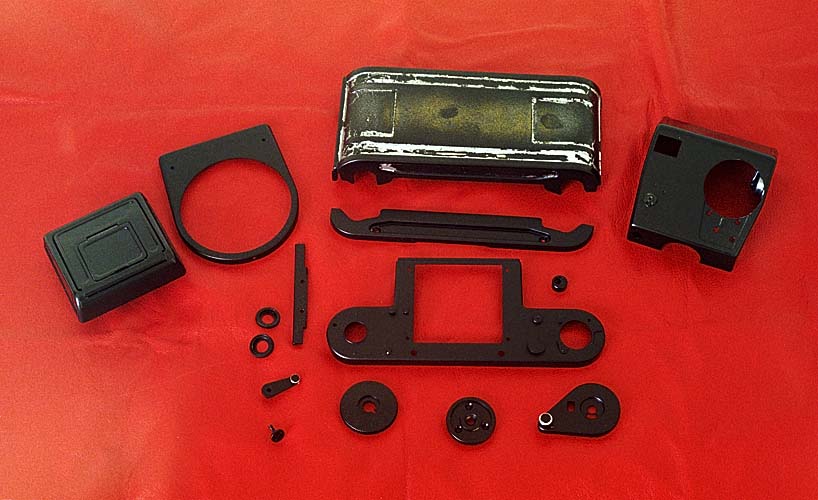 [C414_3A] There turned out to be enough leather here for two or three cameras! |
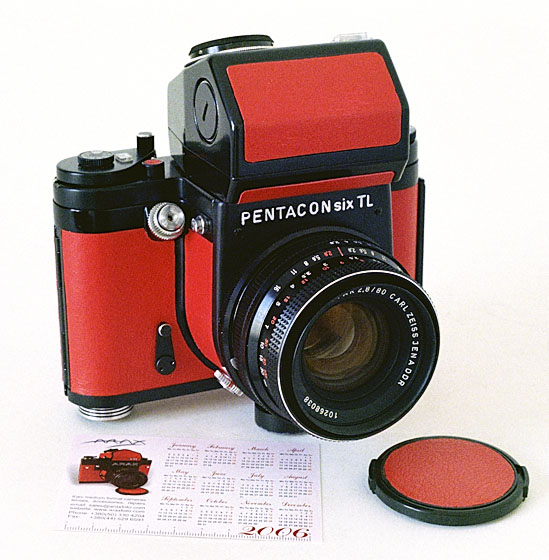 [C414_16A.jpg] |
A lens that shows
feet in red has been used. The red and
black of the lens combine well with the
colouring of the rest of the camera.
The calendar shows a Kiev 60 upgraded by Arax - using the same leather that was applied to this Pentacon Six. The soft touch of the leather is a pleasure to hold. No wonder Hasselblad offered bodies in a range of finishes in the 1990s. It’s all about bringing back the excitement of owning a camera. We might even speak of the sensual pleasure of touching it. This could have been done at such tiny cost, yet – with some of the essential technical improvements – the camera would have captured significant sectors of the world-wide market. |

[Plainprism_1.jpg]
Here the metering prism has been
replaced with an Arsenal plain prism, via the
Baierfoto adapter. It has the original black
leather.
A simulation below shows the prism with
red leather, too.
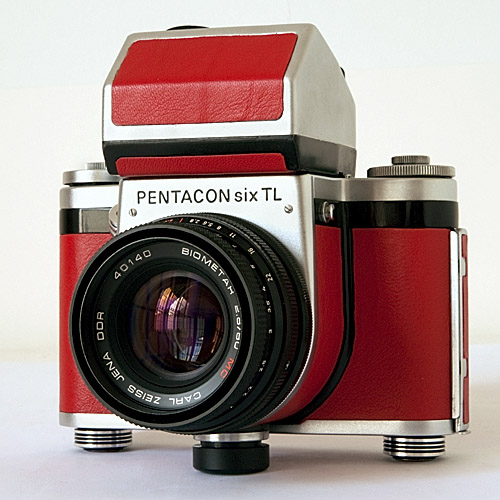
[SilverRed_1.jpg]
I wanted to use some spare pieces of
that lovely red leather, so now this combination
exists, too. In fact, it is my main camera!
By the mid 1970s the market was calling for all-black cameras. This is what the Pentacon Six might have looked like (again, with the Arsenal plain prism).
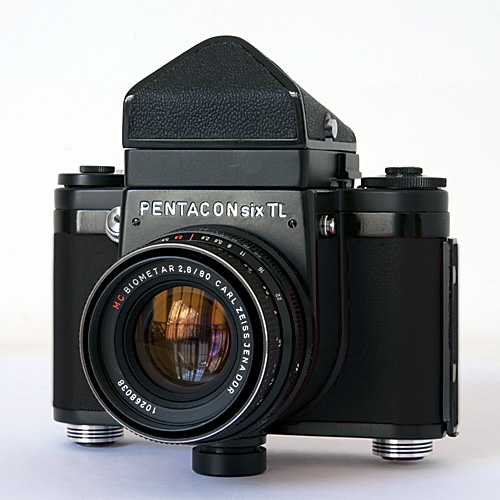
Heinrich Mandermann responded to this
demand with his all-black Exakta 66.
But there never was an all-black
Pentacon Six TL. There should have been.
[allblack_2.jpg]
|
|
 Blue |
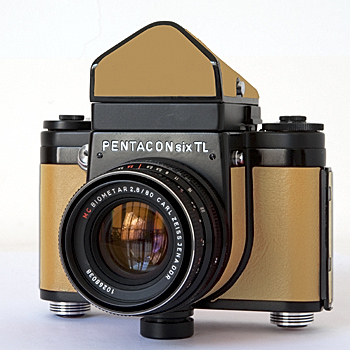 Calfskin |
 Green |
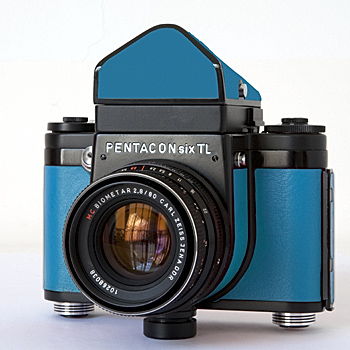 Light Blue |
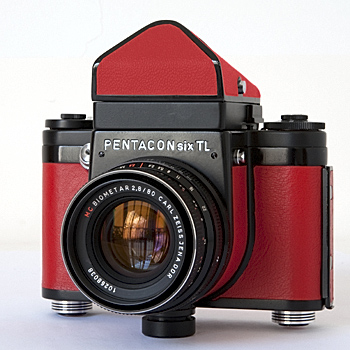 Red |
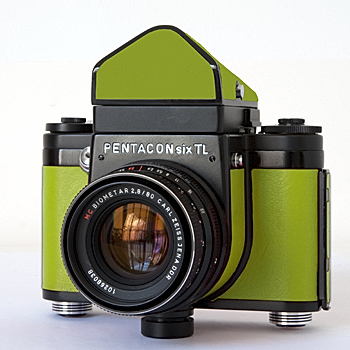 Pale Green |
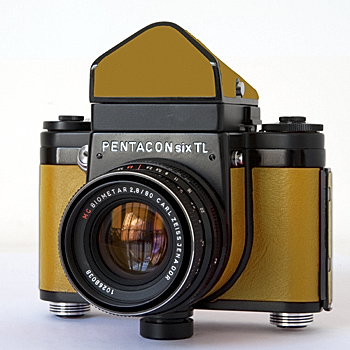 Bronze |
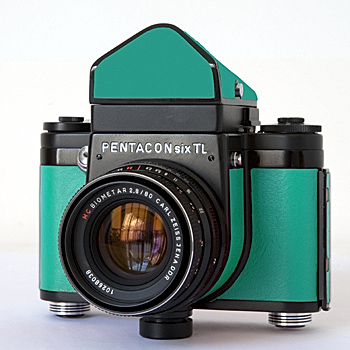 Turquoise |
 Pink |
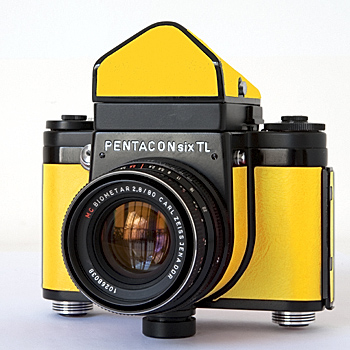 Yellow You may not like it, but some Kiev 60’s this colour have been sold! |
To go to the Bibliography, click here.
To go on to the next section, click
below.
35 Reasons why
development stopped
To go to the beginning of the history section, click here.
To go to introduction to the cameras, click here.
To choose other options, click below.
Home
© TRA First published: June 2010
Latest revision: January 2021